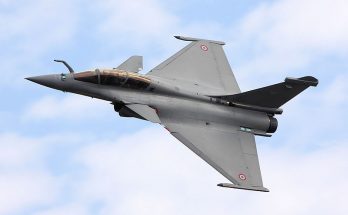
On Monday, June 2, the British government released a new Strategic Defence Review (SDR), the first such review implemented by a Labor government since 1998. It arrives at a time the geostrategic and military environment are undergoing rapid shifts.
Promising a radical break from the past and a transformational new approach, the SDR aims at improving the British armed forces’ warfighting readiness in an ever-shifting defense landscape where autonomous systems have emerged as equally vital as crewed platforms and the value of defense industrial resilience is reasserted.
The review outlines five core ambitions: 1) A “NATO First” approach that strengthens British contributions to European security, 2) establishing a more lethal “integrated force” coupled with stronger homeland defense, 3) military-industrial partnership that drives growth and supports domestic businesses, 4) U.K. technology innovation spurred by lessons from the Ukrainian battlespace, and 5) a whole of society approach that creates national resilience and stronger civilian-military ties.
The following takes a look at key aspects of the latest Strategic Defense Review.
The Threat Environment is Evolving and the post-9/11 Footing No Longer Suffices
Following the end of the Cold War the British military, like all NATO member forces, underwent an elongated period of personnel cuts and equipment downsizing as the operational focus shifted from peer-on-peer industrial-scale warfare to tackling non-state actors in distant theaters. The result was a lighter, more rapidly-deployable force, but one that today would struggle to sustain operation in a high-intensity conflict over an elongated period.
The latest SDR serves as the first such document since 1989 that does not recommend force cuts. This is hardly a major point in its favor, however, as the British Army is now down to just under 73,000 troops.
The SDR proposes increasing Army troop levels to 76,000 and boosting reserves by 20 percent—but only, as the document repeatedly cautions, ‘when funding allows.’
Regarding the strategic threat environment, the SDR mentions Russia as “an immediate and pressing threat”, one capable of quickly rebuilding its land capabilities in the event the Ukraine conflict draws to an end. Meanwhile, China is seen as a “sophisticated and persistent” challenge that leverages its economic, military and technological capabilities to establish dominance in the Indo-Pacific region and put pressure on the rules-based global order.
The paper also notes that both China and Russia are increasing the number and type of nuclear weaponry in their stockpiles as they helm security strategies with this capability at the core.
The Nuclear Option
The SDR is noteworthy for its emphasis on nuclear deterrence. One of the key acquisition programs directly spelled out in the document involves a GBP15 billion ($20.3 billion) investment in sovereign nuclear warheads, essentially a renewal of the legacy Trident nuclear deterrent. This investment will help sustain the U.K.’s Continuous At-Sea Deterrent (CASD) that will be carried out by the Royal Navy’s four new in-production Dreadnought class nuclear-powered ballistic missile submarines (SSBNs) replacing the current Vanguard-class.
Also of note, while not spelled out directly in the SDR, the U.K. is also reportedly examining the possibility of purchasing combat aircraft capable of firing tactical nuclear weapons. This would ostensibly involve procuring F-35A jet fighters equipped with U.S.-made B61-12 bombs that would provide Britain with an air-delivered nuclear deterrent.
The Maritime Domain
As an island nation, the U.K. has always relied upon a strong naval arm and protection of its sea lines of communication.
But for fully two decades the number of surface combatants in the Royal Navy’s ship inventory remained at 19, before recently slipping to just 17 with the announcement of the retirement of Type 23 frigate HMS Northumberland back in November. While replenishment of the existing Type 23 fleet is underway with construction of eight Type 26 City class and five Type 31 Inspiration class frigates, the Royal Navy – like the British Army – has long been tasked with doing more with less.
The SDR does little to correct this, though in perhaps the most noteworthy recommendation of the paper, the government intends to procure 12 SSN-AUKUS conventionally-armed, nuclear powered submarines (SSNs) that will eventually replace the current seven Astute-class SSNs.
The Royal Navy’s carrier strike capability will evolve to include autonomous collaborative uncrewed aerial systems to complement the F-35B wing, as well as expendable, one-way kamikaze drones. Adding a long-range precision strike capability to the decks of the Navy’s two aircraft carriers, HMS Queen Elizabeth and HMS Prince of Wales, is also mentioned.
The SDR takes stock of recent “gray zone” tactics by noting that protection of critical undersea infrastructure will become a core emphasis, with the addition of fleets of uncrewed surface and underwater vessels (USVs and UUVs) equipped with acoustic detection systems and powered by Artificial Intelligence (AI) helping to secure the North Atlantic for the U.K. and NATO.
Overall, the maritime theme within the SDR emphasizes finding alternative methods to achieve a balanced and cost-effective Royal Navy fleet. This includes building upon efforts to field autonomous minehunting systems that will detect and neutralize mines, examining the use of commercial vessels and burden-sharing capabilities with allies to augment assets in non-contested environments, and engaging with commercial partners and private finance to provide enhanced anti-submarine warfare (ASW) capabilities that include uncrewed and autonomous systems.
The Land Domain
No U.K. service branch has suffered more attrition over the past two decades-plus than the British Army. Most of its effectors – be they tanks, artillery and ammunition – date back to the early 1990s. Efforts to modernize armored platforms have suffered from delays and outright cancellations, though several initiatives such as the Challenger 3 main battle tank upgrade, Boxer Mechanized Infantry Vehicle (MIV) family, and the Ajax family of tracked armored vehicles, are all progressing.
Going forward, the British Army will be built upon a “20-40-40” ratio, a high-low mix of capabilities consisting of 20 percent traditional crewed platforms such as Challenger 3 tanks, followed by 40 percent ‘reusable’ uncrewed aerial systems (UASs), and finally 40 percent ‘consumables’ involving rockets, shells, missiles, and attritable kamikaze drones.
The Air Domain
While the sea and land domains received less clarity in terms of specific equipment plans, the SDR provides several specific mentions of note in the air domain.
The first, and perhaps most noteworthy, is a reaffirmed commitment to U.K. investment in the tri-national Global Combat Air Program (GCAP) initiative. A second is the determination to acquire more F-35 Lightning II stealth fighters over the next decade.
Adding more E-7 Wedgetail airborne early warning and control (AEW&C) aircraft – possibly through joint procurement with NATO allies, and augmenting the existing A400M transport fleet also are mentioned. Finally, a replacement for the Hawk T1 and T2 trainer fleets and a revised fast-jet training arrangement are recommended.
However, one major equipment initiative that went without mention is the New Medium Helicopter (NMH) requirement. Intended as a capability bridge while the U.K. irons out its longer-term vertical medium-lift requirements in the 2040s, the NMH is slated to replace the Royal Air Force’s (RAFs) Puma HC2s, the British Army’s fleet of Bell 212 utility helicopters, the RAF’s Bell 412EP utility helicopters, and the U.K. Special Forces’ Airbus AS 365N3 Dauphin utility helicopters.
Investments, Industry and Innovation
While particular equipment details will have to wait until a new Defense Investment Plan is released in the fall, the SDR does provide broad outlines for several investment initiatives.
One of particular note calls for GBP6 billion ($8.1 billion) toward munitions that will enable construction of six new factories in the U.K. through 2028. This initiative calls for building 7,000 new long-range weapons in the U.K. In these instances – as in the case of the aforementioned sovereign nuclear warhead program – the case is being made to tie defense investment to sustainment of local workshare and aiding the U.K. economy.
Other areas of investment include standing up a Cyber and Electronic Command, a funding envelope of GBP4 billion ($5.4 billion) for procuring autonomous systems, and a nearly GBP1 billion ($1.35 billion) allocation towards directed energy weapons.
The SDR also calls for creation of a new “Digital Warfighter Group” that will be deployed alongside conventional forces to analyze battlespace data in real-time, anticipate threats, optimize operational strategy, and accelerate decision-making.
Can the UK afford a major defence spending boost?
The government’s new Strategic Defence Review lays out threats facing Britain and the state of its armed forces, amid questions over missile defence readiness and funding.@EdConwaySky reports. https://t.co/3hiPcUV7Lv pic.twitter.com/bbc6Vp1hll
— Sky News (@SkyNews) June 3, 2025
Conclusion
The new SDR comes across as ambitious and bold and without argument it holds real strategic value. Acknowledging the need to move beyond the post 9/11 defense model, the paper places autonomy, resilience and innovation at the heart of British military planning.
But dig deeper and one particularly big question quickly emerges.
That big question involves funding.
The SDR fails to outline a spending plan beyond what Keir Starmer already declared earlier in February when he outlined plans to increase the British defense budget to 2.5 percent of GDP per year by 2027. He then added that the budget would be raised up to 3 percent of GDP “during the next parliament” and subject to economic and financial conditions. The prime minister also went on to note that the country faced “extremely difficult and painful choices”, which entailed moving monies from the foreign aid budget to top-up the defense allocation without raising government spending.
Since that time the potential knock-on effects of U.S. President Donald Trump’s tariff war threaten to shrink the U.K.’s already-cool growth estimates and further curtail Whitehall’s financial flexibility.
Thus the necessary commitment towards the elevated funding necessary to meet the goals of the SDR instead rests upon hope for a sunnier economic climate.
That commitment also appears untenable on the backs of Defense Secretary John Healy’s statement to parliament that budget control and new efficiencies totaling around GBP6 billion ($8.1 billion) will be undertaken during the current legislative term. Although Healy noted that any such savings will be reinvested back into defense, it hardly elicits confidence for future top-up spending goals, or in his words, make the British Army “ten times more lethal”.
Furthermore, the lack of sufficient funding necessary to jump-start all the changes and domestic production outlined in the SDR means that the 10-year force transformation window inevitably gets pushed back further. In other words, rapid changes necessary to remake the British armed forces will require money – now. Without those investments the 10-year transformation becomes a 15- and even 20-year plan – one subject to changes as the strategic, political and economic environment continues to relentlessly shift.
The idea of waiting until the next parliament also assumes that the current Labor government – already deeply unpopular less than a year into power – will be able to retain a majority after the next election. Possible, of course, but certainly not a guarantee. Particularly if the government has to resort to raising taxes to meeting its own defense targets.
Another aspect to consider is that if Labor does fall from power the SDR likely becomes a dead letter.
Meanwhile, as the government waits until that fateful next election both China and Russia continue investing in their own militaries and military technological advancements.
A bigger question is what will happen at the upcoming NATO summit in The Hague. The summit is expected to involve a request by NATO Secretary General Mark Rutte for members to commit to a 3.5 percent of GDP defense spending target by 2035, coupled with a further 1.5 percent of GDP on military-related investments such as cyber security and infrastructure.
The so-called Hague Investment Commitment will put the U.K. on the defensive unless it agrees to pledge to meet these goals. In the past – as in the case at the NATO 2014 Summit in Wales – members fell back on weasel-wordings such as “commit towards bringing spending up to” rather than agreeing to a hard target. However, under the current political and security environment, the latest target – agreed to between Rutte and Donald Trump – will not be as easy to elude.
Additionally, according to some reports, the revised NATO commitments may exclude certain spending categories—such as soldiers’ pensions and funding for intelligence agencies—that currently count as defense spending under existing Alliance rules. While the U.K. currently allocates about 2.3 percent of its GDP to defense under the current standards, this figure would drop to 2.1 percent if the definition of qualifying defense spending is narrowed. As a result, the gap to reach the revised 3.5 percent target would be even greater.
Despite Keir Starmer’s “100 percent confidence” that the government can meet the warfighting goals laid out in the SDR under current funding plans, the paper’s authors have already gone on record stating this is only possible if the budgetary floor rises to 3 percent of GDP. Which again, is less than the 3.5 percent target that will be required of NATO members.
Therefore, something will have to give: Either a firm fiscal commitment, or another SDR that promises much and delivers little.
Dan Darling is Forecast International’s director of military and defense markets. In this role, Dan oversees a team of analysts tasked with covering everything from budgeting to weapons systems to defense electronics and military aerospace. Additionally, for over 17 years Dan has, at various times, authored the International Military Markets reports for Europe, Eurasia, the Middle East and the Asia-Pacific region.
Dan's work has been cited in Defense News, Real Clear Defense, Asian Military Review, Al Jazeera, and Financial Express, among others, and he has also contributed commentary to The Diplomat, The National Interest and World Politics Review. He has been quoted in Arabian Business, the Financial Times, Flight International, The New York Times, Bloomberg and National Defense Magazine.
In addition, Dan has made guest appearances on the online radio show Midrats and on The Media Line, as well as The Red Line Podcast, plus media appearances on France 24 and World Is One News (WION).




